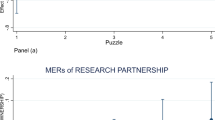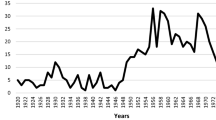Abstract
For sustainable and effective innovation, who should own an academic patent obtained as a result of funded research? The issue of ownership can influence the motivation of academic researchers. In this paper, we address this issue from the perspective of engineering graduate students who have experience of R&D projects. We aim to investigate engineering graduate students’ views on inter-organizations aspects of patent ownership; and patent ownership policies within university. In this paper, we carried out classification tree analyses of preferred ownership categories, using various factors related to ‘researchers and the environment for R&D,’ ‘technology,’ ‘patenting activities,’ ‘sponsors,’ ‘currently existing ownership policy,’ and ‘compensation policy’. Our findings can help design an effective ownership policy that promotes innovation by incorporating the views of students who will be important asset for future innovation.


Similar content being viewed by others
References
Ajzen, I. (1991). The theory of planned behavior. Organizational Behavior and Human Decision Processes, 50, 179–211.
Ajzen, I. (2002). Perceived behavioral control, self-efficacy, locus of control, and the theory of planned behavior. Journal of Applied Social Psychology, 32(4), 665–683.
Audretsch, D. (2000). Is university entrepreneurship different? Mimeo, Indiana University.
Baark, E. (1988). The value of technology: A survey of the Chinese theoretical debate and its policy implications. Research Policy, 17(5), 269–282.
Baldini, N., Grimaldi, R., & Sobrero, M. (2007). To patent or not to patent? A survey of Italian inventors on motivations, incentives, and obstacles to university patenting. Scientometrics, 70(2), 333–354.
Bercovitz, J. E. L., & Feldman, M. P. (2007). Fishing upstream: Firm innovation strategy and university research alliances. Research Policy, 36(7), 930–948.
Breiman, L., Friedman, J. H., Olshen, R. A., & Stone, C. J. (1984). Classification and regression trees. Los Angeles, CA: Wadsworth.
Chamas, C. I. (2008). Nanotechnology intellectual property in Brazil: Preliminary research note. World Patent Information, 30(2), 146–149.
Chang, Y. W., Hsu, P. Y., & Wu, Z. Y. (2015). Exploring managers’ intention to use business intelligence: The role of motivations. Behaviour and Information Technology, 34(3), 273–285.
Chen, Y., Gupta, A., & Hoshower, L. (2006). Factors that motivate business faculty to conduct research: An expectancy theory analysis. Journal of Education for Business, 81(4), 179–189.
Chew, P. K. (1992). Faculty-generated inventions: Who owns the golden egg? Wisconsin Law Review, 75, 259–306.
Chiang, C. F., & Jang, S. S. (2008). An expectancy theory model for hotel employee motivation. International Journal of Hospitality Management, 27(2), 313–322.
Chiu, Y. J., & Chen, Y. W. (2007). Using AHP in patent valuation. Mathematical and Computer Modelling, 46(7/8), 1054–1062.
Cunningham, R. (2014). Information environmentalism: A governance framework for intellectual property rights. Cheltenham: Edward Elgar Publishing.
Deng, Y. (2007). Private value of European patents. European Economic Review, 51(7), 1785–1812.
Duval-Couetil, N., Pilcher, J., Weilerstein, P., & Gotch, C. (2014). Undergraduate involvement in intellectual property protection at universities: Views from technology transfer professionals. International Journal of Engineering Education, 30(1), 60–71.
Friedman, J., & Silberman, J. (2003). University technology transfer: Do incentives, management, and location matter? Journal of Technology Transfer, 28(1), 17–30.
Geuna, A., & Rossi, F. (2011). Changes to university IPR regulations in Europe and the impact on academic patenting. Research Policy, 40(8), 1068–1076.
Göktepe-Hulten, D., & Mahagaonkar, P. (2010). Inventing and patenting activities of scientists: In the expectation of money or reputation? The Journal of Technology Transfer, 35(4), 401–423.
Grimaldi, R., & Von Tunzelmann, N. (2002). Assessing collaborative, pre-competitive R&D projects: The case of the UK LINK scheme. R&D Management, 32(2), 165–173.
Grönqvist, C. (2009). The private value of patents by patent characteristics: evidence from Finland. The Journal of Technology Transfer, 34(2), 159–168.
Hall, B. H., & Zeidonis, R. H. (2001). The patent paradox revisited: An empirical study of patenting in the US semiconductor industry, 1979–1995. RAND Journal of Economics, 32(1), 101–128.
Harhoff, D., & Hoisl, K. (2007). Institutionalized incentives for ingenuity-patent value and the German Employees’ Invention Act. Research Policy, 36(8), 1143–1162.
Haupt, R., Kloyer, M., & Lange, M. (2007). Patent indicator for the technology life cycle development. Research Policy, 36(3), 387–398.
Hippel, E. V., & Krogh, G. V. (2003). Open source software and the “private-collective” innovation model: Issues for organization science. Organization Science, 14(2), 209–223.
Holdford, D., & Lovelace-Elmore, B. (2001). Applying the principles of human motivation to pharmaceutical education. Journal of Pharmacy Teaching, 8(4), 1–18.
Jaffe, A. B., & Lerner, J. (2001). Reinventing public R&D: Patent policy and the commercialization of national laboratory technologies. RAND Journal of Economics, 32(1), 167–198.
Ju, Y., Sohn, S. Y., Ahn, J., & Choi, J. Y. (2014). Balanced scorecard based performance analysis of accreditation for engineering education. Industrial Engineering and Management Systems, 13(1), 67–86.
Kenney, M., & Patton, D. (2009). Reconsidering the Bayh–Dole Act and the current university invention ownership model. Research Policy, 38(9), 1407–1422.
Kim, K. S. (2009). A study on joint research and development agreements. Journal of Business Administration and Law, 19(3), 405–435.
Kollner, H., & Dowing, M. (2004). Licensing as a commercialization strategy for new technology-based firms. Research Policy, 33(8), 1141–1151.
Kumar, V., & Jain, P. K. (2003). Commercialization of new technologies in India: An empirical study of perceptions of technology institutions. Technovation, 23(2), 113–120.
Landry, R., Amara, N., & Rherrad, I. (2006). Why are some university researchers more likely to create spin-offs than others? Evidence from Canadian universities. Research Policy, 35(10), 1599–1615.
Lerner, J., & Tirole, J. (2002). Some simple economics of open source. The Journal of Industrial Eonomics, 50(2), 197–234.
Link, A. N., & Siegel, D. S. (2005). University-based technology initiatives: Quantitative and qualitative evidence. Research Policy, 34(3), 253–257.
Long, F. (1989). Technology. Trade and international economic policy. Technology in Society, 11(2), 261–266.
Lynskey, M. J. (2006). Transformative technology and institutional transformation: Coevolution of biotechnology venture firms and the institutional framework in Japan. Research Policy, 35(9), 1389–1422.
Marion, T. J., Dunlap, D. R., & Friar, J. H. (2012). The university entrepreneur: A census and survey of attributes and outcomes. R&D Management, 42(5), 401–419.
Mendoza, P. (2007). Academic capitalism and doctoral student socialization: A case study. The Journal of Higher Education, 78(1), 71–96.
Nerkar, A., & Roberts, P. W. (2004). Technological and product-market experience and the success of new product introductions in the pharmaceutical industry. Strategic Management Journal, 25(89), 779–799.
Nyttiggorande av högskoleuppfinningar SOU. (2005). 95. Available at ¨/http://www.regeringen.se/sb/d/108/a/53408S.
O’Shea, R. P., Chugh, H., & Allen, T. J. (2008). Determinants and consequences of university spinoff activity: A conceptual framework. Journal of Technology Transfer, 33(6), 653–666.
Organisation for Economic Co-operation and Development. (2003). Turning science into business: Patenting and licensing at public research organizations. OECD Publishing.
Owen-Smith, J., & Powell, W. W. (2001). To patent or not: Faculty decisions and institutional success at technology transfer. The Journal of Technology Transfer, 26(1–2), 99–114.
Patel, S. H. (1996). Graduate students’ ownership and attribution rights in intellectual property. Indiana Law Journal, 71(2), 481–512.
Rasmussen, E., Moen, Ø., & Gulbrandsen, M. (2006). Initiatives to promote commercialization of university knowledge. Technovation, 26(4), 518–533.
Reitzig, M. (2004). Improving patent valuations for management purposes validating new indicators by analyzing application rationales. Research Policy, 33(6–7), 939–957.
Roberts, E. (1991). Entrepreneurs in high technology, lessons from MIT and beyond. Oxford: Oxford University Press.
Roberts, D., Hughes, M., & Kertbo, K. (2014). Exploring consumers’ motivations to engage in innovation through co-creation activities. European Journal of Marketing, 48(1/2), 147–169.
Schwartz, E. S. (2004). Patents and R&D as real options. Economic Notes by Banca Monte dei Pashi di Siena SpA, 33(1), 23–54.
Sellenthin, M. (2004). Who should own university research? An exploratory study of the impact of patent rights regimes in Sweden and Germany on the incentives to patent research results. Technical report, Department of Technology and Social Change, Linköping university.
Siegel, D. S., Waldman, D., Atwater, L., & Link, A. (2004). Toward a model of the effective transfer of scientific knowledge from academicians to practitioners: Qualitative evidence from the commercialization of university technologies. Journal of Engineering and Technology Management, 21, 115–142.
Siegel, D. S., Waldman, D., & Link, A. (2003). Assessing the impact of organizational practices on the productivity of university technology transfer offices: An exploratory study. Research Policy, 32, 27–48.
Silvernagel, C., Schultz, R. R., Moser, S. B., & Aune, M. (2009). Student-generated intellectual property: Perceptions of ownership by faculty and students. Journal of Entrepreneurship Education, 12, 13–33.
Sohn, S. Y., & Ju, Y. H. (2015). Design and implementation of a six sigma game to develop entrepreneurship in engineering students. International Journal of Engineering Education, 31(2), 1–13.
Sohn, S. Y., & Lee, M. Y. (2012). Conjoint analysis of R&D contract agreements for industry-funded university research. The Journal of Technology Transfer, 37(4), 532–549.
Sohn, S. Y., Lee, W. S., & Ju, Y. H. (2013). Valuing academic patents and intellectual properties: Different perspectives of willingness to pay and sell. Technovation, 33(1), 13–24.
Sohn, S. Y., & Moon, T. H. (2003). Structural equation model for predicting technology commercialization success index (TCSI). Technological Forecasting and Social Change, 70(9), 885–899.
Sohn, S. Y., & Moon, T. H. (2004). Decision tree based on data envelopment analysis for effective technology commercialization. Expert Systems with Applications, 26(2), 279–284.
Sterzi, V. (2013). Patent quality and ownership: An analysis of UK faculty patenting. Research Policy, 42(2), 564–576.
Sun, Y., Wang, N., Yin, C., & Zhang, J. X. (2015). Understanding the relationships between motivators and effort in crowdsourcing marketplaces: A nonlinear analysis. International Journal of Information Management, 35(3), 267–276.
Von Krogh, G., & Spaeth, S. (2007). The open source software phenomenon: Characteristics that promote research. The Journal of Strategic Information Systems, 16(3), 236–253.
Vroom, V. H. (1964). Work and motivation. New York, NY: Wiley.
Walter, S. G., Schmidt, A., & Walter, A. (2016). Patenting rationales of academic entrepreneurs in weak and strong organizational regimes. Research Policy, 45(2), 533–545.
Weckowska, D. M., Molas-Gallart, J., Tang, P., Twigg, D., Castro-Martínez, E., Kijeńska-Dąbrowska, I., et al. (2015). University patenting and technology commercialization—Legal frameworks and the importance of local practice. R&D Management. doi:10.1111/radm.12123.
Acknowledgements
This work was supported by the National Research Foundation of Korea (NRF) Grant funded by the Korea Government (MSIP) (2016R1A2A1A05005270). We thank W. S. Lee and J. H. Park who participated in the early stage data analysis of this research.
Author information
Authors and Affiliations
Corresponding author
Appendix
Rights and permissions
About this article
Cite this article
Sohn, S.Y., Han, E.J. Engineering graduate students’ views on the effective ownership of academic patents. J Technol Transf 44, 132–154 (2019). https://doi.org/10.1007/s10961-017-9598-4
Published:
Issue Date:
DOI: https://doi.org/10.1007/s10961-017-9598-4




